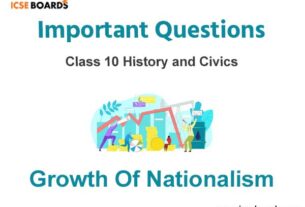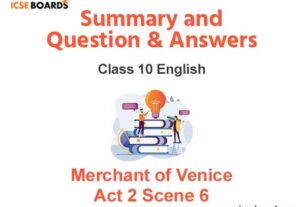ICSE students should refer to The First World War ICSE Class 10 History notes provided below. These revision notes have been prepared based on the latest ICSE Class 10 History Books for the current academic year. Revising notes prior to the exams is really important to get excellent marks in History Class 10 exams. Also, refer to ICSE Class 10 History solutions to understand all chapters properly.
ICSE Class 10 History and Civics The First World War
Students can refer to the quick revision notes prepared for Chapter The First World War dependence 1857 in Class 10 ICSE. These notes will be really helpful for the students giving the History and Civics exam in ICSE Class 10. Our teachers have prepared these concept notes based on the latest ICSE syllabus and ICSE books issued for the current academic year.
The First World War ICSE Class 10 History
Flow chart

Know the Terms
1. Imperator : A German ship, built in 1912. It was the largest ship in the world.
2. Czar : The Ruler of Russia before the October Revolution of 1917.
3. Lusitania : A British ship which was sunk by the German boats in 1915.
4. Versailles : A suburb of Paris where the first conference of all Allies was held.
5. League of Nations : A new international organization set up after the Treaty of Versailles to ensure enduring world peace.
6. Romanov : The ruling dynasty in Russia.
7. Hohenzollern : The ruling dynasty in Germany.
8. Habsburg : The ruling dynasty of Austria – Hungry.
9. Allies : The name given to victorious powers of the First World War.
10. Second International : A voluntary organization which raised voice against the probability or war and against militarisation.
11. Treaty of Versailles : A major treaty signed after the First World War.
Know the Dates
➢ 1870-71: France was defeated by Germany and lost Alasce-Lorraine.
➢ 1882: Triple Alliance including Germany, Austria-Hungary and Italy was formed.
➢ 1904: Britain and France entered into a secret agreement according to which Britain was to have a free hand in Egypt and France was to take over Morocco.
➢ 1904-05: Japan defeated Russia after signing an agreement with Britain and was able to extend its influence in the far-east.
➢ 1907: Triple Entente comprising France, Russia and Britain was formed.
➢ 1908: Austria annexed the Ottoman provinces of Bosnia and Herzegovina. Russia could not prevent it due to an open threat by Germany.
➢ 1912: Four Balkan countries, i.e., Serbia, Bulgaria, Montenegro and Greece started a war against the Turks.
➢ 28th June, 1914: Archduke Franz Ferdinand, the heir to the throne of Austria-Hungary, was assassinated at Sarajevo, the capital of Bosnia.
➢ 28th July, 1914: Austria declared war on Serbia. Beginning of the First World War.
➢ 1st August, 1914: Germany declared war on Russia.
➢ 3rd August, 1914: Germany declared war on France.
➢ 4th August, 1914: German troops marched into Belgium to pressurise France. Britain declared war on Germany.
➢ 1915: Italy joined the war against Austria-Hungary and Germany. German U-boats sank the British ship called Lusitania.
➢ 6th April, 1917: US declared war against Germany.
➢ 1917: Russia withdrew from the war following the October Revolution.
➢ January, 1918: US proposed a peace programme.
➢ March, 1918: Russia signed a peace treaty with Germany.
➢ July, 1918: Britain, France and US launched a military offensive. Germany and her allies started collapsing.
➢ September 1918: Bulgaria withdrew from the war.
➢ October, 1918: Turkey surrendered.
➢ 3rd, November, 1918: Austria-Hungary surrendered.
➢ 11th November, 1918: Germany signed an agreement and the war ended.
➢ January-June, 1919: The victorious powers met in a conference first in Versailles and later in Paris.
➢ 28th June, 1919: The major treaty — The Treaty of Versailles was signed between Germany and the Allies.
➢ 1922: Turkey was proclaimed a Republic.
Know the Personalities
1. Archduke Franz Ferdinand : Heir to the throne of Austria – Hungary; was assassinated in 1914.
2. Lenin : Leader of the October Revolution in Russia in 1917.
3. Woodrow Wilson : President of the United States.
4. Kaiser William II : German Emperor.
5. Lloyd George : Prime Minister of Britain.
6. George Clemenceau : Prime Minister of France.
Causes, Course and End of the World War-I
Quick Review
(i) Causes of the First World War
➢ Franco-German Rivalry : France wanted to avenge its defeat in the hands of Germany and reoccupy Alsace and Lorraine captured by the Germans.
➢ Also both the countries wanted to seize Morocco in Africa. Thus, a war between them was inevitable.
➢ Anglo-German Rivalry : Germany started to increase its Naval power to compete with England. Huge ships were constructed and they started to widen the Kiel Canal.
➢ Enmity between Austria and Russia on Balkan Politics : Russia completely supported Serbia while Austria opposed Serbia. With the rapid decline of the Ottoman Empire, Some of the Balkan states became independent such as Greece, Romania, Serbia and Bulgaria. Australia annexed two Balkan states —Bosnia and Herzegovina. This was against Serbia’s ambition of a United Slavonic state. This increased the rivalry between Austria and Serbia.
➢ Scramble for new Colonies: France, Spain, Portugal and England had established colonies in various parts of the world. With Germany emerging as a powerful industrial nation, there was great rivalry among the European nations to set up and control colonies.
➢ Intense Nationalism of ‘Narrow’ Kind : At this time, it was that love towards one’s own country demanded the hatred of others.
➢ German ambition to be a World Power: Herman Kaiser William II went about proclaiming that Germany ‘was going to be the leader of the world’. This German ambition of a world empire and the war propaganda by the newspapers, especially in Germany, added to the tension.
➢ The Division of Europe into camps and formation of Alliances: Increasing tension made the countries look for allies. Germany signed the dual Alliance with Austria – Hungry which became the Triple Alliance when in 1882 Italy joined the group.
➢ In 1907, England, Russia and France signed the Triple Entente. These two groups were hostile to each other.
➢ Lack of International Organization : As there was no organization to enforce international laws or to control, nations bent on thinking only of their own interests, there was bitterness and tension among the nations.
➢ Immediate Cause: Archduke Francis Ferdinand, heir to the Austrian throne, was assassinated at Sarajevo in Bosnia on 28th June 1914 by a Serbian nationalist.
Austria held Serbia responsible for the murder and sent an ultimatum. As Serbia refused to comply with some of the conditions, Austria declared war against Serbia on 28th July, 1914.
➢ By August, most of the powers were involved in the war. On one side were Serbia, Russia, France, England, Japan, Italy, and America- called the Allies.
On the other side were Germany, Austria, Turkey and Bulgaria—known as the Central Powers.
➢ The war was fought on all three continents, using destructive weapons on land, on the sea and under it, causing immense destruction and suffering.
➢ For almost three years, Germany witnessed victory after victory. The German Army could reach upto the Marne River 15 miles from Paris.
➢ The Western Front
(a) The British Army used tanks which helped them a lot. The Germans launched under sea boats-submarines or U-boats.
(b) One of the German U-boats sank the US liner Lusitania carrying many European and American passengers. Other American ships were also sunk.
America was angered and offended and joined the war in April 1917.
➢ The Eastern Front
(a) The Central Powers (Germany and Austria) captured parts of Russia such as Livonia and Estonia.
(b) Germany also captured a large part of Romania.
(c) Turkey joined the war with the Central Powers. In the beginning, it was difficult for the Allies to defeat them. But the British defeated the Turkish Army in Bersheba and captured Syria and Palestine. Turkish Army was forced to leave Mesopotamia.
(d) 1917 witnessed Revolution in Russia. The Czar’s rule was overthrown. Russian Government was in the hands of Communists (Bolsheviks). Lenin signed a Peace Treaty-The Treaty of Brestlitovsk which ended the war between Germany and Russia.
➢ The War Ends
(a) The entry of America in the First World War on the side of the Allies provided huge resources of men and money.
(b) The Allies launched massive military offences against the Germans.
The German Emperor Kaiser William II lost hopes of winning. Soon, he abdicated the throne.
(c) Germany became a Republic and signed an agreement to stop fighting-the Armistice on 11th Nov. 1918 i.e., the Armistice Day.
(d) Various treaties were signed to bring an end to the First World War.
– The Treaty of St. Germain with Austria.
– The Treaty of Neuilly with Bulgaria.
– The Treaty of Sevres with Turkey.
– The Treaty of Trianon with Hungary.
(e) The Treaty of Versailles, signed on 28th June 1919 in Versailles (France), was an agreement with Germany who was blamed for imposing a war on the Allies.
(f) Germany was forced to hand over the Saar coal mines to France for 15 years as compensation for damage to its coal mines during the war.
(g) France got back Alsace-Lorraine.
(h) Germany had to cede parts of her pre-war territories to Denmark, Belgium and Czechoslovakia.
(i) The territories and colonies held by Germany in various parts of the world were placed as ‘Mandates’ under the overall control of the League of Nations.
(j) The German Army was checked. It was not allowed to have submarines or Air Force.
(k) The Rhine Valley was demilitarized.
(l) Germany was forced to pay a massive amount in form of war compensation.
(m) The treaty also worked out the setting up of the League of Nations.
(n) This treaty was very humiliating for Germany and led to the rise of Nazism.
(o) This treaty crippled Germany, but soon it regained power and wanted to avenge the blow to its position, thus leading to the Second World War.
TOPIC-2
Results/Consequences Of the First World War
Quick Review
➢ Results of the War
(a) It changed the political map of Europe and ended monarchies in Russia, Austria-Hungary and Germany.
(b) New political ideologies swept Europe-–Nazism and dictatorism. Fascism took strong roots especially in Germany and Italy.
(c) The United States with its vast resources emerged as a major world power.
(d) The First World War resulted in an unimaginable loss of life and suffering.
(e) It led to financial problems as money spent on it ran into millions of pounds.
(f) It led to the formation of the League of Nations in 1920.
(g) The League of Nations was set up ‘to promote International co-operation and to achieve peace and security’.
(h) There were 42 original members.
(i) It had its headquarters at Geneva.
(j) The Assembly, the Council, the Secretariat, the permanent Court of International Justice and the International Labour Organization were the principal organs of the League of Nations.



